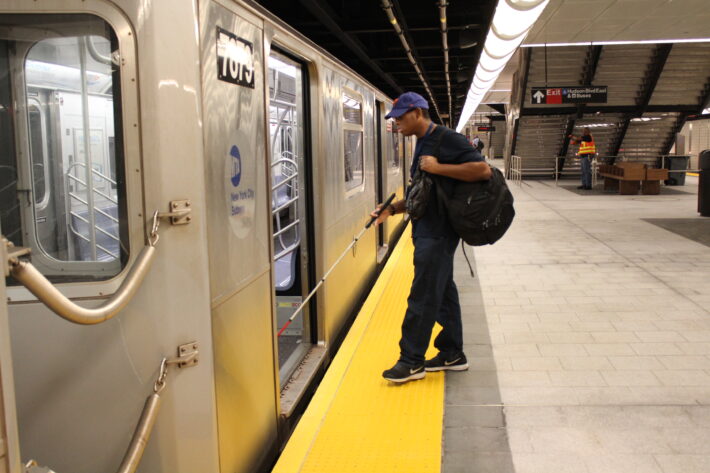
Hashim Kirkland, 33, a visually impaired man who lives in the Bronx and regularly takes several subway lines to commute to Manhattan, walked with a shuffle into the new 34th St.-Hudson Yards station, a cane in his hand.
The MTA website calls the station “a modern marvel with 21st Century amenities” that complies with the Americans with Disabilities Act, passed in 1990, which prohibits discrimination in transportation. Kirkland, who works in the kitchen at a nursing home in the Bronx, said he finds the station more accessible than other stations in certain aspects, but less so in other ways.
Kirkland said he was glad that the warning stripes at the platform’s edges have pronounced bumps, which made his cane shake as he ran it over them.
“Forty to fifty percent of the platforms I use do not have warning stripes,” he said. “And a lot of existing stripes are worn out. You can barely feel the bumps. I have to measure the platform’s edge with my cane, and try to stay at least a foot away from it.”
But he was also disappointed that there are no poles along the platform’s edges, unlike many stations.
“People push and pull during rush hours, and I have fallen on the platform. So I stand close to a pole and can wrap my cane around it if I fall over,” he said.
The station, which officially opened on Sept. 13, is expected to see 200,000 daily riders by 2025, according to a Reuters article.
The 890,000 New York City residents with disabilities use public transportation at about the same rate as non-disabled residents except when it comes to the subway. About 35 percent of New Yorkers with disabilities use the subway – 10 percent less than non-disabled residents, according to a report released in July by the Center for Independence of the Disabled in New York, a nonprofit organization founded in 1978. The report urges the MTA to improve the stations’ accessibility for the 185,000 visually impaired residents by repairing elevators and equipping the platforms with warning stripes.
By December 2014, a third of the city’s subway platforms were still not in an acceptable state of structural repair, in terms of safety, according to a report published this month by Citizens Budget Commission, a nonprofit organization that works to improve New York’s financial and social services. The report says that at the current rate of repair, some of the 469 stations will not be fixed until 2067.
Kirkland, who has no vision in his right eye and some central vision in his left eye, praised the new station’s lighting.
“It is very bright. I can see the ground and the stairs when I walk on them. I can see train’s door when it opens. It makes me feel safer,” he said.
Inadequate lighting in stations is a common problem for several visually impaired people interviewed for this article. Only 40 percent of the stations Kirkland uses are well-lit, he said. Another shared complaint is the lack of announcements that include the letter of incoming trains. The stations for the C, E and M lines at West 23rd Street, which are a block away from Visions, a social service center for the visually impaired, do not have such announcements, for instance.
The MTA has not responded to repeated requests for comments.
Despite the station’s bright lighting, Kirkland had to strain his eyes to recognize the glass elevator shaft, especially when the cabin is not in it. The shaft, which MTA’s website calls ADA-compatible, encloses a few metal structures, but to Kirkland it looks too transparent from the side. He prefers the metal and concrete elevator shafts he finds in other stations.
About 19 percent of New York’s 469 stations are ADA-compatible, according to the MTA’s website. The company plans to make 100 stations ADA-compatible by 2020. But given the subway system’s age and configuration, it is “impossible or cost-prohibitive” to make each station accessible, MTA spokesman Kevin Ortiz said in a recent Huffington Post article.
Kirkland complained about announcements and warning stripes at an accessibility meeting with MTA officials last year, but said nothing has changed since then.
“People at the meeting told me the officials were looking at their phones or doing other things,” he said. “I don’t think they care.”